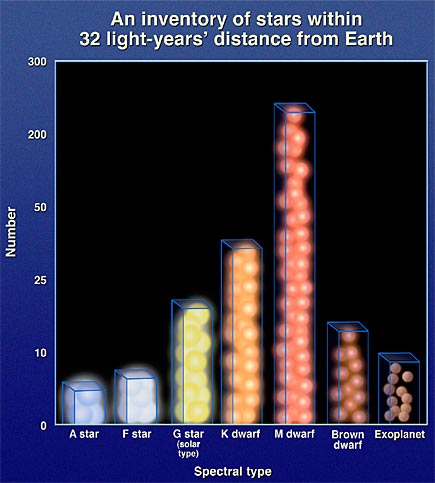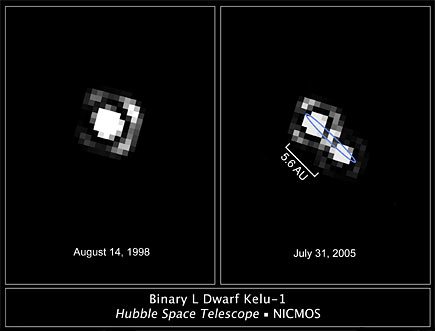Take a crystal glass and drop it on the floor, you’ll end up with a few large pieces, a greater number of smaller shards, and lots and lots of tiny bits. For decades, astronomers assumed the same pattern would hold for interstellar clouds breaking up into stars. Large collapsing gas clouds — stellar birthplaces — were well known to break up into a few massive stars, more medium-sized ones like the Sun, and lots of low-mass red dwarfs. That's the pattern we see not just among stars born together in a cluster, but also among the stars scattered throughout our neighborhood of space generally.

The smaller and cooler stars become, the more of them there are — until you get deep into the range of the coolest red dwarfs. Then, it turns out, the trend reverses. Brown dwarfs, which have even lower masses, are less abundant in space than was once expected.
Alan MacRobert
Would this trend extend to even smaller stellar fragments, known as brown dwarfs? These are objects with masses too low for them to ignite hydrogen fusion at their centers and light up as actual stars. (They're often defined as any object having between 13 and 75 Jupiter masses.) At some lower limit, the cloud-breakup process should become inefficient and cease to form smaller fragments. Or at least not so many.
But where was that lower limit? Brown dwarfs are extremely dim and hard to find, much less study. Astronomers confirmed the first ones only in 1995, as modern infrared technology came on line. So no one knew where the bottom would be. Was interstellar space full of these tiny star-formation bits? Would they outnumber all visible stars put together?
No, it turns out. At this week's American Astronomical Society meeting in Long Beach, California, astronomers described the most comprehensive survey yet of objects in the "solar neighborhood," the region within 10 parsecs (32.6 light-years) of the Sun. The survey is part of an ongoing project known as RECONS, the Research Consortium on Nearby Stars. It has added a lot of dim bulbs to the tally of our near neighbors. The list within 10 parsecs now includes 239 red dwarf stars — but only 12 brown dwarfs.
More could be hiding that are still too cool and faint, but there can't be many. Astronomers seem to have found the turnaround where ever-tinier fragments become fewer in number with declining mass rather than more numerous (see graph above).

Brown dwarfs almost never pair up with stars, but they do pair up with each other. These infrared Hubble images are from a sequence showing orbital motion of the binary Kelu-1. The two low-mass components swing around each other about once every 40 years (blue ellipse). In 1998 they were too close to be resolved, but by 2005, they had clearly moved apart.
An accurate binary orbit tells the mass of the system and sometime the mass of each object separately. These two have masses of 61 and 50 Jupiters. They are therefore too small to burn as stars, but too large to have formed as planets. Based on spectroscopy and the total estimated mass of the system, astronomers suspect there's a third, unresolved brown dwarf closely orbiting the brighter one.
Alan MacRobert
RECONS scientists also announced a different brown-dwarf finding at the meeting. Not only are there relatively few of these objects floating in isolation, there are almost none orbiting normal stars. The reason for this so-called "brown-dwarf desert" among binary companions is a mystery.
It's not new. Astronomers doing radial-velocity hunts for objects closely orbiting stars (by looking for their gravitational tugs) have turned up lots of giant planets but almost no companions in the brown-dwarf mass range.
Those hunts, however, have mostly been sensitive to objects that orbit within 5 astronomical units of the host star (Jupiter’s distance from the Sun). To look for brown dwarfs orbiting at much wider distances, RECONS astronomers took deep, high-resolution infrared images of 233 nearby stars using the Hubble Space Telescope. Although double stars are extremely abundant, the team found only one double in which the companion is a brown dwarf. (And that object, interestingly, turned out to be double itself.)
“Brown dwarfs are running out of places to hide; they’re just not there,” sums up RECONS team member Sergio Dieterich (Georgia State University), who led the search for brown-dwarf companions. “The deeper we look, the fewer of them we find.”
For reasons unknown, nature has an especially hard time forming a brown dwarf in tandem with a normal star. “We have seeds in interstellar gas clouds, and they continue to sprout to form stars, but they don’t form a lot of brown dwarfs,” says RECONS team leader Todd Henry (Georgia State University).
However, this odd binary taboo does not extend to pairs of two brown dwarfs. Such low-mass binaries are actually turning out to be fairly common among the brown-dwarf population generally. An example is the pair Kelu-1, resolved in the infrared Hubble image above.
See the RECON group's press release for more.
 2
2
Comments
Justin S
January 7, 2009 at 12:11 pm
It has been my assertion for some time that the anthropic principle shows that brown dwarfs should be rare. Suppose they outnumbered ordinary stars significantly. If they did then in the 4 billion year history of the solar system, there would be a significant chance that a brown dwarf would have passed within the inner solar system. That, of course, would have scrambled the planetary orbits and we would not be here to talk about it.
You must be logged in to post a comment.
Sergio Dieterich
January 9, 2009 at 12:13 am
In Reply to the comment posted by Justin S:
As we tried to explain at the AAS conference, I still think the best case for the rarity of brown dwarfs is the fact that we don't see them in large numbers even with sensitive enough telescopes.
Even if brown dwarfs were as abundant as some still think they are, I do not believe that they would pose a serious threat to the orbital stability of the solar system. When you calculate the probabilities of stellar encounters, you come to the conclusion that even with a stellar density 2/3 higher than the one we observe now the chances of 2 stars coming that close to each other are almost zero. This is true at least for the solar neighborhood, but not true for higher density environments such as globular clusters and the center of the galaxy.
You do raise an interesting point though. The outermost part of the solar system is the Oort cloud of commets. Only this part of the solar system is large enough to have significant chances of coming in contact with the influence of other stars. Could the passing of another star cause an instability in the Oort cloud and therefore put a few comments in a collision ccourse with other bodies? That has likely happend in the past.
You must be logged in to post a comment.
You must be logged in to post a comment.